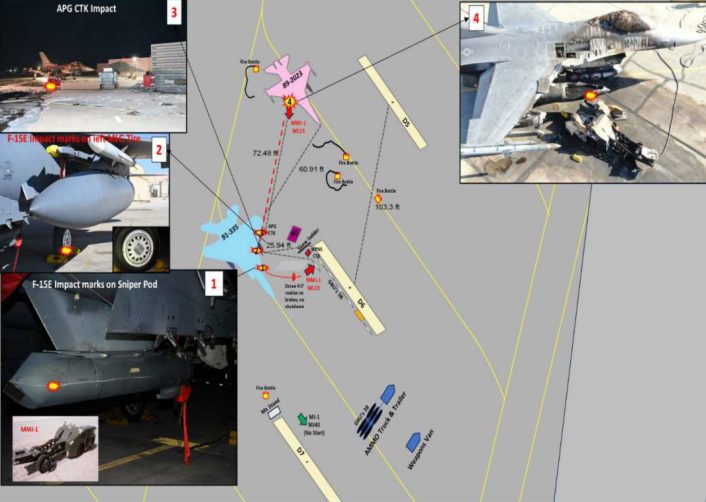A U.S. Air Force F-16C was struck by an out-of-control MJ-1 jammer, causing a fuel leak. Sparks emitted from the jammer ignited a fire that engulfed both the jammer and the right side of the F-16C.
The U.S. Air Forces Europe – Air Forces Africa has published a report from the Accident Investigation Board regarding a ground incident that took place on Nov. 17, 2023.
On that day, an F-16 with tail number 89-02023, assigned to the 555th Fighter Squadron, 31st Operational Group, 31st Fighter Wing at Aviano Air Base, Italy, was stationed at a deployed, undisclosed location in Southwest Asia. At the time of the incident, the aircraft was parked, unmanned, and unarmed on a ramp approximately 60 feet away from an F-15E, tail number 91-0335, of the 48th Fighter Wing, from RAF Lakenheath, UK, where a team of weapons loaders was working to remove munitions.
The F-16 was equipped with two 370-gallon external fuel tanks, an AN/ALQ-131 electronic countermeasure pod, two MXU-648-EA travel pods, an AN/AAQ-33 Sniper Advanced Targeting Pod (ATP), and two inert AIM-120B Captive Air Training Missiles.
The team working on the F-15E consisted of a team chief (MXLC1), a weapons loader (MXLC2), and the weapons loader driver (MXLC3), who were using an MJ-1 weapons loader, commonly referred to as a “jammer” or bomb lift.
Around 2.200 local time, while beginning to load munitions onto the F-15E, MXLC2 began operating the jammer. After starting it and placing it in reverse toward the F-15E, MXLC2 realized he could not stop the jammer. As it continued in reverse, the jammer struck the Sniper ATP (advanced targeting pod), causing MXLC2 to hit his head and scrape his back on the F-15’s bomb rack unit, pinning him to the dashboard of the jammer. The jammer then collided with the F-15E’s landing gear tire, redirecting its path toward the F-16.
After moving under the F-15E’s left fuel tank, MXLC2 was thrown off the jammer, which then hit a nearby toolbox and continued unmanned toward the F-16. The jammer struck the F-16’s right fuel tank, leading to a fuel leak. Shortly afterward, sparks from the jammer ignited a fire that engulfed both the jammer and the right front side of the F-16.

The mishap resulted in approximately $30,241,892 in damage to government equipment and an estimated $4,954 in environmental cleanup costs. In particular, the damage sustained by the F-16 was significant but limited to the right front section. The MJ-1 jammer struck the forward portion of the right 370-gallon external fuel tank, causing an immediate fire. This led to severe damage to the aircraft’s panels, bulkhead, and internal lines. The right-side tank was damaged from the impact of MMJ-1 and destroyed in the subsequent fire. The front top portion of the tank was melted off during the fire and was non-recoverable. The F-15E’s Sniper pod sustained an external scratch traveling the length of the pod on the outboard left side surface.
During the mishap, the MJ-1 operator, MXLC2, sustained minor abrasions on both legs, the left arm, the back of the head, and more significant abrasions on the left side of the back.
The Accident Investigation Board (AIB) President determined that the mishap was caused by MXLC2’s loss of situational awareness and confusion about the specific MJ-1 model he was operating, as well as his misjudgment of the distance to the F-15E when he began using the jammer.
The MJ-1, commonly referred to as a “jammer,” is a standard lift truck used by the United States Air Force to transport, load, and unload a wide range of munitions and equipment for various aircraft. The truck has controls at the rear, allowing the load crew to make precise adjustments when positioning munitions during loading and unloading operations.
The MJ-1B/C lift truck closely resembles the newer MJ-1C model at first glance, but the MJ-1C includes several component upgrades. Though the differences between the B/C and C models are generally minor, they affect key systems such as braking, fuel, steering, and electrical components, as well as the wheel paneling.
In the braking system, the MJ-1C features an updated foot brake located in a different position than on the older MJ-1B/C. For the fuel system, the MJ-1C no longer includes a clear bowl to check for water in the fuel, but it remains otherwise unchanged. The steering system on the MJ-1C has a minor alteration, with the steering manifold removed from beneath the operator’s seat cushion, though the steering pump remains the same as the B/C version. Finally, the front wheel fenders on the MJ-1C have slip-resistant steps, unlike the conforming style fenders found on the earlier MJ-1B/C models.
This confusion led MXLC2 to panic, mistakenly pressing the accelerator instead of the brake, and failing to implement the proper emergency shutdown procedures. These errors caused the MJ-1 to collide with the F-15E’s landing gear at high speed, which resulted in the failure of the MJ-1’s hydrostatic drive pump and prevented the centering mechanism from retracting the pump’s control lever to the neutral position, thereby stopping the jammer.
The AIB President also concluded that a lack of proper documentation for the MJ-1 fleet at the “undisclosed location” (that could be Muwaffaq Salti/Al-Azraq Air Base in Jordan, where the RAF Lakenheath’s F-15Es deployed last year), along with a lax adherence to Air Force standards and technical procedures by the maintenance personnel, were contributing factors in the mishap.
H/T to @ryankakiuchan for the heads up

